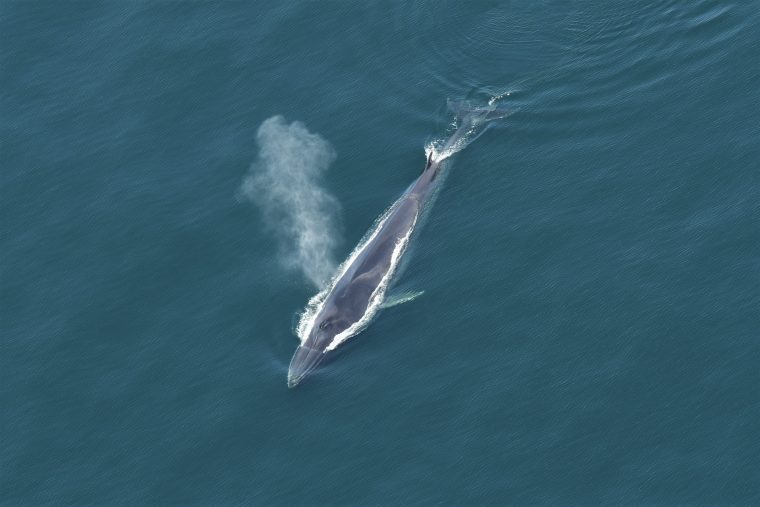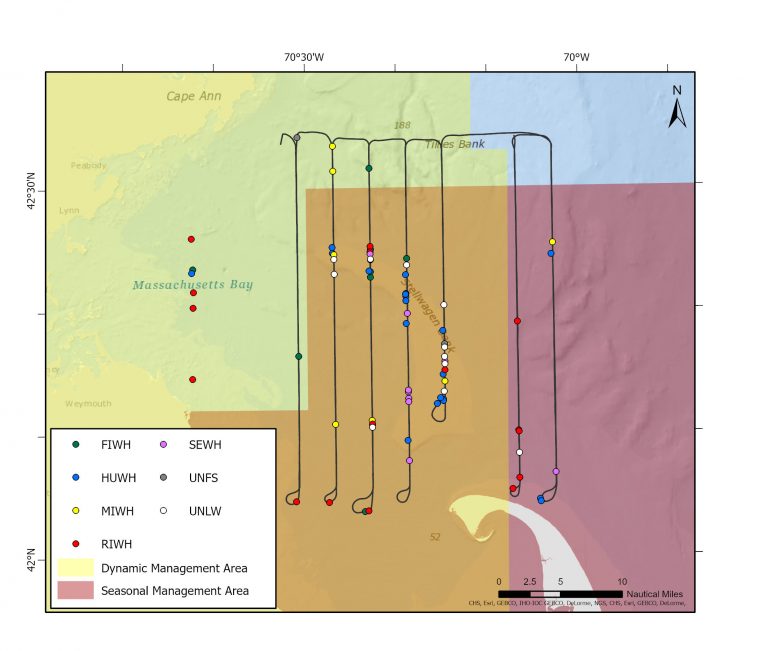These surveys contribute to developing wind energy sustainably

BOSTON, MASS. (April 28, 2022) – During a special research flight on Monday, the New England Aquarium aerial survey team sighted more than 100 whales of several species, including 27 critically endangered North Atlantic right whales.
Aquarium researchers, Associate Scientist Orla O’Brien and Research Assistant Katherine McKenna, flew a five-hour flight on April 25 focused on how survey altitude affects researchers’ ability to detect whales. The New England Aquarium primarily flies aerial surveys over the waters south of Nantucket that are designated for offshore wind development, but this week’s flight in Massachusetts Bay was a strategic effort to better understand how to merge survey data collected before, during, and after wind energy construction. Surveys that occur during and after wind turbine construction will need to be flown at a higher altitude to account for the turbine height, which is about 800 feet. This special survey was flown over Massachusetts Bay and Stellwagen Bank National Marine Sanctuary because these areas typically contain many whales, giving researchers the best opportunity to collect the data they need to address questions about changes in flight altitude.
“On this special flight, we flew each track line at a lower and higher altitude. Comparing these data, and data from previous flights, ensures that we can correctly identify and interpret any changes in the number of animals seen before, during, and after construction,” said Dr. Jessica Redfern, Senior Scientist and Chair of the Aquarium’s Spatial Ecology, Mapping, and Assessment (EcoMap) program.
While aboard the five-hour flight, researchers O’Brien and McKenna spotted multiple marine mammal species, including critically endangered right whales, and an abundance of humpback whales, fin whales, sei whales, and dolphins. They also noted some right whales close to the entrance of Boston Harbor. Passengers aboard New England Aquarium Whale Watches in partnership with Boston Harbor City Cruises have been seeing right whales recently.
The Center for Coastal Studies and Northeast Fisheries Science Center regularly fly surveys to document right whale activity in this area throughout the spring migration season. Aquarium scientists communicated closely with teams from each organization to ensure this particular flight was conducted in coordination with other aerial research.
“We were really pleased to see so many whales and collect valuable data needed for our project. Massachusetts Bay and Stellwagen Bank are hotspots for whales, and we were grateful to our research colleagues for helping us collect valuable information on this flight,” O’Brien said.

The Aquarium has conducted aerial surveys over the waters south of Martha’s Vineyard and Nantucket for more than a decade, collecting data on all marine animals with a focus on protected species of whales and sea turtles. These surveys have primarily been funded by the Massachusetts Clean Energy Center, Bureau of Ocean Energy Management, wind energy developers, and private foundations. While wind turbine construction in southern New England has not yet begun, the surveys help monitor changes in animal populations, identify various animal species, and recognize trends using standardized data that has been collected over many years. Determining where right whales occur and how they are using these habitats provides crucial information that can be used to better protect the species. Aquarium scientists are also monitoring the occurrence of sharks, tunas, and billfishes in the offshore wind lease areas.
North Atlantic right whales are a critically endangered species, with an estimated population of less than 350 individuals. The whales travel hundreds of miles while searching for tiny crustaceans, called copepods, which they feed on in large volumes. Warming waters in the northern Atlantic Ocean have led to shifts in right whale habitat use, with the animals adjusting where they feed off the northeast U.S. and Canada. Southern New England waters have become an increasingly important habitat for the species in the past 12 years.
MEDIA CONTACT:
Pam Bechtold Snyder – psnyder@neaq.org, 617-686-5068
